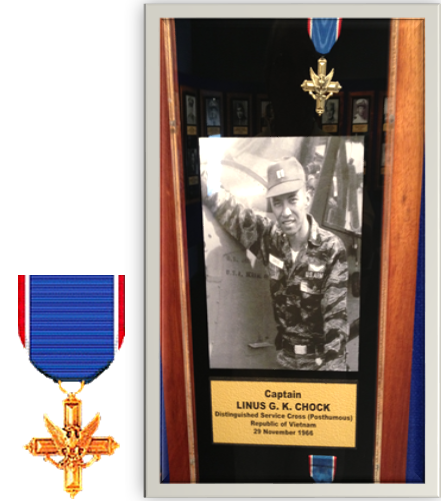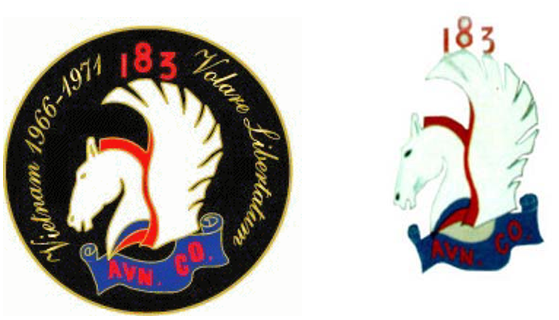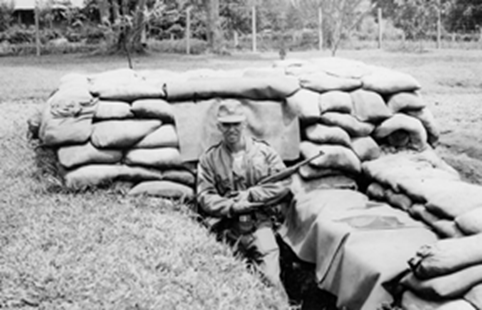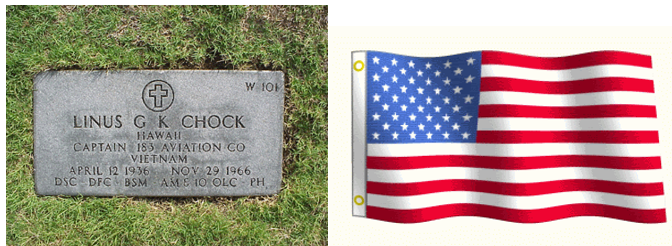
VIETNAM CHRONICLES
TRUE BUT UNTOLD STORIES
CAPTAIN LINUS CHOCK

DISTINGUISED SERVICE CROSS, PHAN THIET, VIETNAM
COL. MACK GIBSON IN MEMORIUM
COL. GIBSON WAS THE COMMANDER OF THE 183 AVIATION COMPANY
“It is certainly good of you to post a memoriam to Captain Lee Chock. We all knew and appreciated what a terrific officer and gentleman that Lee Chock was. He was an inspiration for all with whom he served. He was dedicated, selfless, courageous and he led by example. In addition to his serious and professional approach towards discharging his duties, he had a great sense of humor which made life in that hostile environment much more bearable for his subordinates and peers.”



Captain Linus Chock---Bao Loc
Obtained from the Honolulu newspaper from the date of the funeral
FUNERAL RITES FRIDAY FOR CAPTAIN LINUS CHOCK
Funeral services will be held Friday at Sacred Heart Church for U. L. Army Capain Linus G. K. Chock, 30, of 1788 Nanea Street, Honolulu, who died November 29 from injuries received during combat in Viet Nam. Captain Chock a member of the 183rd Aviation Company, was piloting a helicopter when he suffered head wounds from small arms fire during a reconnaissance mission.
He was the 61st Islander killed fighting in Viet Nam.
Captain Chock was holder of the National Defense Service Medal with Oak Leaf Cluster, the Viet Nam Service Medal, and the Air Medal with five oak leaf clusters.
Born April 12, 1936, in Honolulu, Captain Chock graduated from Maryknoll High School, in 1954 and from Santa Clara University in 1960. He took officers training in Seattle, Washington after joining the Army.
Subsequently, he received missile and communications training at White Sands, New Mexico; pilot training at Fort Monmouth, New Jersey, and was assigned to Korea in 1964.
Following duty at Randolph Air Force Base, San Antonio, Texas, he was assigned to Viet Nam in May of this year.
A Solemn Requiem Mass will be sung at 10 a.m. Friday at Sacred Heart Church, followed by burial with full military honors at the National Cemetery of the Pacific.
Friends may call at Williams Mortuary from 6 to 9 p. m. Thursday and from 7:30 to 9 p. m. Friday. A Rosary will be recited at 7:30 p. m. Thursday.
The family requests, in lieu of flowers friends wishing to honor the memory of Captain Chock may send contributions to9 the Maryknoll High School Scholarship Fund.
Captain Chock is survived by his wife, Sun Kan Chock, one son, Patrick K. Chock, his parents, Mr. and Mrs. Alfred F. Chock, three sisters, Mrs. Walter (Audrey) Swideret of Chicago, Illinois, Mrs Raymond (Germaine) Mendoza of Los Angeles, California, and Mrs Joseph (Antonella) Bennett of Pasadena, California and Master Sergeant Alfred W. Chock, serving with the U. S. Air Force in Libya, Africa, and Master Sergeant Rodney H. W. Chock, serving in the U. S. Air Force in Viet Nam.
Distinguished Service Cross
Chock was awarded the the Distinguished Service Cross
The Distinguished Service Cross, also known as the DSC, is our Nation's second highest award for valor, second only to the Medal of Honor. The Distinguished Service Cross was created during the First World War and was signed into law by President Woodrow Wilson on January 2, 1918.
Chapter 3, Army Regulation 600-8-22 (Military Awards)
The Distinguished Service Cross, section 3742, title 10, United States Code (10 USC 3742), was established by Act of Congress 9 July 1918 (amended by act of 25 July 1963).
The Distinguished Service Cross is awarded to a person who while serving in any capacity with the Army, distinguished himself or herself by extraordinary heroism not justifying the award of a Medal of Honor; while engaged in an action against an enemy of the United States; while engaged in military operations involving conflict with an opposing or foreign force; or while serving with friendly foreign forces engaged in an armed conflict against an opposing Armed Force in which the United States is not a belligerent party. The act or acts of heroism must have been so notable and have involved risk of life so extraordinary as to set the individual apart from his or her comrades.

THIS IS CHOCK’S PLACE ON THE Washington DC WALL
LINUS GERARD K CHOCK
Army - CAPT - O3
Age - 30
Date of Birth - Apr 12, 1936
From - HONOLULU , HAWAII
LINUS GERARD K CHOCK INFO PAGE
CAPT - O3 - Army - Reserve
30 year old Married, Caucasian, Male
Born on Apr 12, 1936
From HONOLULU, HAWAII
Length of service 12 years.
His tour of duty began on May 16, 1966
Casualty was on Nov 29, 1966
SOUTH VIETNAM
Hostile, died while missing
FIXED WING - PILOT
AIR LOSS, CRASH ON LAND
Body was recovered
Religion
ROMAN CATHOLIC
Panel 12E - - Line 128

WHAT HAPPENED?
CAPTAIN JOE MUCELLI STATEMENT. MUCELLI WAS ON THE GROUND AFTER IT HAPPENED. MUCELLI WAS THE BAO LOC MACV SENIOR INFANTRY ADVISER. BELOW IS THE MUSCELLI STATEMENT IN HIS OWN WORDS, AND IS UNEDITED.
What happened on that day was as follows:
The 1st of the 44th ARVN Infantry Battalion was moving from Bao Loc to the east. They were accompanied by their Bn Advisor, Lt Jim Brawner, a former USMC NCO who fought in Korea, and his assistant Bn Advisor Sgt Boles, who was packing a PRC25 radio. Just to the east of the little hamlet with the gas station that straddled highway 20 they were ambushed by what later proved to be the 186th Main Force Battalion, which occupied dug in camouflaged positions from which they attacked. The 1/44th was holding it's own and had received artillery support, when a bullet chopped off the base of the radio antenna on Sgt Boles backpack. Somewhere around this time Cpt Chock appeared overhead and had limited to nonexistent communications with Boles, apparently only when he was directly overhead. Chalk was lured closer to the ground, because he could not hear from altitude. This was Chalks big mistake. The ARVN communication was less reliable with PRC10 radios and apparently the VC were also jamming the frequencies. Lam Dong Sector sent out the Armored car Platoon, which consisted of 4 M8 armored cars which were WWII vintage wheeled vehicles equipped with a 37mm gun, a coax 30 caliber Browning and a 50 caliber Browning mounted on top of the turret, which was open topped. The 37mm was especially lethal with canister rounds, long before proven on Guadalcanal by the Marines when they annihlated a Japanese bn crossing the Tenaru River. The problem with the 50 caliber was that it was designed to be used as an anti aircraft weapon on the M8 and could only be fired in the opposite direction from the 37mm unless the vehicle commander came out of the turret and stood on the rear deck, which was not conducive to long life! I was at the Popular Forces training center with Sgt John Hough, when we heard the 50 caliber fire and immediately drove back to the advisor compound, picked up our gear and an interpreter, I think Sgt Thuy?, and started to head out. The Senior Advisor, I think Col Corcoran, said to Sgt Hough "You can't go out there, you only have a week left here!, whereupon Hough said "No sir, I have six years left!", meaning his time to retire! When we got out there the shooting was over anyway. The entire M8 platoon was killed, except for one soldier who had gone to get a haircut and didn't get back in time to go with them. All of the M8's had been knocked out by RPG 7 rounds, which blew nickel sized holes in the armor, after which anything inside, grenades, unexpended 37mm rounds, etc detonated. It was a grisly sight looking in those vehicles, We removed the remains of the crews with wires late that afternoon, though in one case, the remains were removed in Bao Loc at the motor pool with hoses thorough the floor drains. All of them eventually had to be hosed out, to eliminate the terrible smell of rotting chunks of flesh. The 1/44th had over 30 troops killed, but neither Jim nor Sgt Boles had been wounded. Captain Chock’s plane was shot down as you described and it slid through the scrub jungle just north of HWY 20. He may have been trying to put it down on the road, though that would have been hard since the knocked out M-8s were scattered over an area about 100 meters long. His presence alone, over the contact area probably caused the VC battalion to withdraw prematurely, because they were probably unaware of the communications problem the advisors were having, and expected TACAIR to be showing up, as well as better coordination of artillery when they were in their withdrawal phase. Interestingly, many months later, a Lt Jewell, who also was a Infantry Bn Advisor, was flying with one of the sector Huey gunships when through a break in the fog they spotted about 75 individuals snaking through the elephant grass of a clearing and carrying large packs. They engaged them with rockets and machine guns, but got shot down for their troubles They safely landed in a clearing and was shortly after rescued by a slick and the other Sector gunship. Shortly thereafter we got into the area where their earlier target had been. We didn't find any casualties, but we found several large packs filled with about a hundred brassieres, and some embroidered handkerchiefs, with the date 29 November 1966 and a statement about the great victory. I mailed them to Jim Brawner.
Captain Joe Mucelli, is the son of medical doctor, at New York State University. Mucelli attended New York State University and was commissioned a 2nd Lt. from the ROTC. This action resulted in Mucelli being awarded the Silver Star from General Abrams. It was downgraded from the Distinguished Service Cross. General Lee, 11 Corp Senior Advisor, recommended that the award be upgraded to the Metal of Honor. The paperwork has since BEEN LOST. Mucelli served 45 months in Bao Loc. Mucelli has since passed away in San Francisco, in 2012.

Picture of the WW11 armored vehicle
CWO Ron Allen Statement in his own words.
Allan was the second Army pilot that day. Today he is a retired Delta pilot, and is living in California.
November 29, 1966
Bao Loc, Lam Dong Province, Republic of Viet Nam
The morning G2 meeting was held at the MACV HQ compound. I, Seahorse 29, was assigned to escort an RVN convoy through the province on Hwy 1. The convoy was comprised of two dozen, or so, supply vehicles accompanied by a security detachment from the local RVN Ranger Battalion. Assigned to move with the convoy was 1/Lt Jim Brunner, MACV Advisor, and my FM Communication link with the convoy. I was informed just before departing with my observer that My Platoon Leader, Capt. Chock, would be arriving at Bao Loc later in the morning.
I picked up the convoy at the southwest border of Lam Dong Province, established communications with Jim Brunner, as did my observer with his counterparts. Approximately 2-hours later, the convoy arrived at Bao Loc. While they took a break, I returned to Bao Loc base and refueled. Capt. Chock had already arrived and I briefed him on the mission. He wanted me to evaluate a wing-mounted, forward-facing gun system comprised of two 7.62mm, M-60 machine guns mounted on the wing hard points. He explained that he was having all his pilots in the platoon fly this ship to assess the feasibility of the system. I then traded aircraft with Capt. Chock and my observer then flew with him as he joined me for the continuance of the mission.
I was in the process of sending a new set of ciphered coordinates to the artillery battery to keep current with the convoy’s position, about 12 km east of Bao Loc, when I observed the convoy taking hostile fire. This was immediately confirmed by Jim reporting they were taking heavy fire from the south side of the highway. When the second recoilless weapon hit the rear armored car, the source location was readily identified, along with many dug-in positions in front of a line of heavier vegetation.
Artillery was not yet registered. I gave them a new set of coordinates and to let me know when they were ready for a fire mission. In the interim, I decided to engage the target with gunfire to give the ground element some support and asked Capt. Chock if he wanted to follow with rockets. Following our second run, the artillery guys were ready. I made one additional run, expending the remaining ammo, as I called for an adjustment round and advised Capt Chock to remain north of the highway, that I was laying in artillery.
Things got real busy, adjusting artillery, requesting air strike, calling for medivac, coordinating with Jim on the ground, stopping artillery and clearing in medivac. With the medivac came a light gun team (Hueys with guns and rockets). I was really glad to see them. Then more artillery, never got the air strike. I have no recollection of how long all this took. Occasionally, I looked up to see if Capt Chock was still there north of the highway. It all ended as fast as it had begun, “Charlie” was gone. I radioed Seahorse 20 and got no reply. Then I climbed up to where I saw him orbiting north only to find out that It was Hilly Wilbanks, an AF FAC from Dalat, who was waiting for the air strike. Another call to the base, then Jim Brunner called on the FM…”We found your other Seahorse, a crash with two fatals.” I do not even remember landing back at base.
My next recollection was back at the MACV compound. Capt. Chock’s body was delayed in being returned. Likely due to his being of Polynesian descent, he was mistaken as being an RVN casualty and placed in the wrong conveyance. When I saw him…well, I was horrified. He had suffered multiple wounds. The head wound had distorted and disfigured his appearance…an image I will never forget.
To me he was Capt. Chock, my platoon leader. To most of the other aviators in 2nd Platoon, 183rd RAC, he was “Lee”, with whom they had deployed only months earlier. I regret not having had the opportunity to know him as a friend…but he is a permanent fixture in my heart and a brother he will always be.
CWO Ron Allen
Seahorse 29
Chan Le was a Vietnamese observer from Phan Thiet. He was supposed to go to Bao Loc with Chock.
Chan Le wrote in an eMail below. In his own words.
Dear Capt. Kloppenburg,
I am very happy to get in contact with you, a pilot of Second Platoon Seahorse working in Phan Thiet. After four years working with Seahorse, I left Phan Thiet in 1968 that time is a sad story which I will never forget. I don't remember exactly, maybe it was November 1966 or 1967. I get an order from Operation Center to fly for cover in an operation in Lam Dong province. Because the car that was supposed to bring me to airfield was broken down, I was late by about 10 minutes. Captain Chock (I don't remember his first name) took off for Bao Loc, then picked up one observer, Lieutenant Nguyễn Đình Hoè, who had a permit to go on vacation in December for his wedding.
I missed that mission, and about two hours later, an officer of the Operation
Center arrived at my house to give notice to my wife: "Your husband has died
with the pilot in Lâm Đồng." But I was at home. Another observer died for me.
Ten year ago, when I travelled to Washington DC, I hope to see the name of
Captain Chock in the Wall Monument but I didn't because I don't know his last
name. Captain Chock was the platoon leader at that time, he had prepared to go
home, I bought one shirt for his wife, but he died a month before going home.
Captain Chock may have been a native of Hawaìi, one time he talked with me about Hawaii. In 2001, I was there to remember that a friend has died for my country.
Mr. Chan Le,
Captain Richard L. Kloppenburg story.
The "rest of the story"
My eMail back to Chan Le
You and I were the LUCKIEST men on earth on that day. I was the Army pilot in Bao Loc, Lam Dong. I was also a U.S. Army in pilot in the 2nd Platoon and Captain Chock was my platoon leader. I was Seahorse 28. On that day I was away on R & R. Captain Linus Chock was called upon to take my place, in my absence, to fly "cover" for a convoy on highway 20, between Bao Loc and the sub sector headquarters at Di Linh. I remember exactly the date, which was November 29, 1966.
The Viet Cong ambushed the convoy and subsequently overran the vehicles in the convoy. Two americans and several ARVN soldiers also died as a result of the ambush. The convoy commander, a Major Graney, and a Lieutenant were the names of the americans killed during the ambush. It was only the second day in Bao Loc for the killed American Lieutenant. I never met him. The convoy mission was planned days in advance. I believe that the Viet Cong were notified early and subsequently planed the ambush. It was a resupply mission so as to resupply the sub sector MACV in Dieh Linn (sp). I believe that the mission did not have to occur. I think that the subsector could have been resupplied by helicopter. I delivered their mail by including all mail in a “pouch”, which I thru out the window of my airplane, over the compound,.
I also have felt guilty that Captain Chock died flying a mission, that I would have been flying. Captain Linus Chock was of Hawaiian decent and was a career U.S. Army officer. Captain Linus Chock is buried in the Punch Bowl Cemetery in Honolulu. I have visited his grave. The Viet Cong captured a small American tank with a 50 caliber machine gun on the top of the tank. The Vietnamese operators of the tank were killed and subsequently the Viet Cong took control of the machine gun. At that time Captain Chock was shooting rockets at the Viet Cong on the ground. The Viet Cong used the machine gun to shoot down the L-19 airplane with Captain Chock and the Vietnamese observer Lt. Nguyen Dinh Hoe. Chock and Hoe were not killed when the airplane crashed, but were captured and tortured and killed shortly after the airplane crashed. There was some difficultly identifying Captain Chock because of his Hawaiian decent, he looked very oriental and was dressed in tiger fatigues (they thought he was Vietnamese). Captain Perrin flew to Bao Loc to identify Captain Chock. I am sending this email to Frank Perrin, who lives in New York state. I am sure you will hear from him.
After returning to Bao Loc, from R & R, I flew over the crash site. The Army Birddog was still on the ground at the crash site. Subsequently, I asked to be transferred to the Platoon headquarters in Phan Thiet. Now you know how I came to Phan Thiet and met Lt. Phong and the other ARVN observers. Captain Chock had an oriental wife that spoke very little English. After several years, looking for his wife, I found that she had recently passed away. Shortly thereafter I learned that Captain Chock had a son. The mother never told the son about his father. I then found Captain Chock's brother, who lives in Texas. I then connected Captain Chock's son and the rest of his family.
Now the story has gone full circle and you now know the "rest of the story". Hope your health is good, and you live a long life.
Richard L. Kloppenburg
Captain, U.S. Army
Vietnam 1966 and 1967
Americans killed that day.
Major Donald Graney. He was the assistant ROTC PMS at the University of Chattanooga. Upon arrival in Bao Loc he took everyone aside, including me, and indicated that we were going to win this war on his tour. He wanted all of us to "suck it up" and give a larger effort by everyone so as to accomplish that mission.
Captain Paul Van Hosey---KIA with Major Graney. He was found dead with several bullet holes in his legs, suggesting that he was tortured and then executed by the Viet Cong. He had only been in country for less than two weeks. He was only in Bao Loc for a few days. I never met him because I was on R&R.
CAPTAIN JOE MUCELLI SECOND STATEMENT
Captain Chock’s plane was shot down and it slid through the scrub jungle just north of HWY 20. He may have been trying to put it down on the road, though that would have been hard since the knocked out M-8s were scattered over an area about 100 meters long. His presence alone, over the contact area probably caused the VC battalion to withdraw prematurely, because they were probably unaware of the communications problem the advisors were having, and expected TACAIR to be showing up, as well as better coordination of artillery when they were in their withdrawal phase. Interestingly, many months later, a Lt Jewell, who also was a Infantry battalion advisor, was flying with one of the sector Huey gunships when through a break in the fog they spotted about 75 individuals snaking through the elephant grass of a clearing and carrying large packs. They engaged them with rockets and machine guns, but got shot down for their troubles They safely landed in a clearing and were shortly after rescued by a slick and the other Sector gunship. Shortly thereafter we got into the area where their earlier target had been. We didn't find any casualties, but we found several large packs filled with about a hundred brassieres, and some embroidered handkerchiefs, with the date 29 November 1966 and a statement about the great victory. I mailed them to Jim Brawner.

